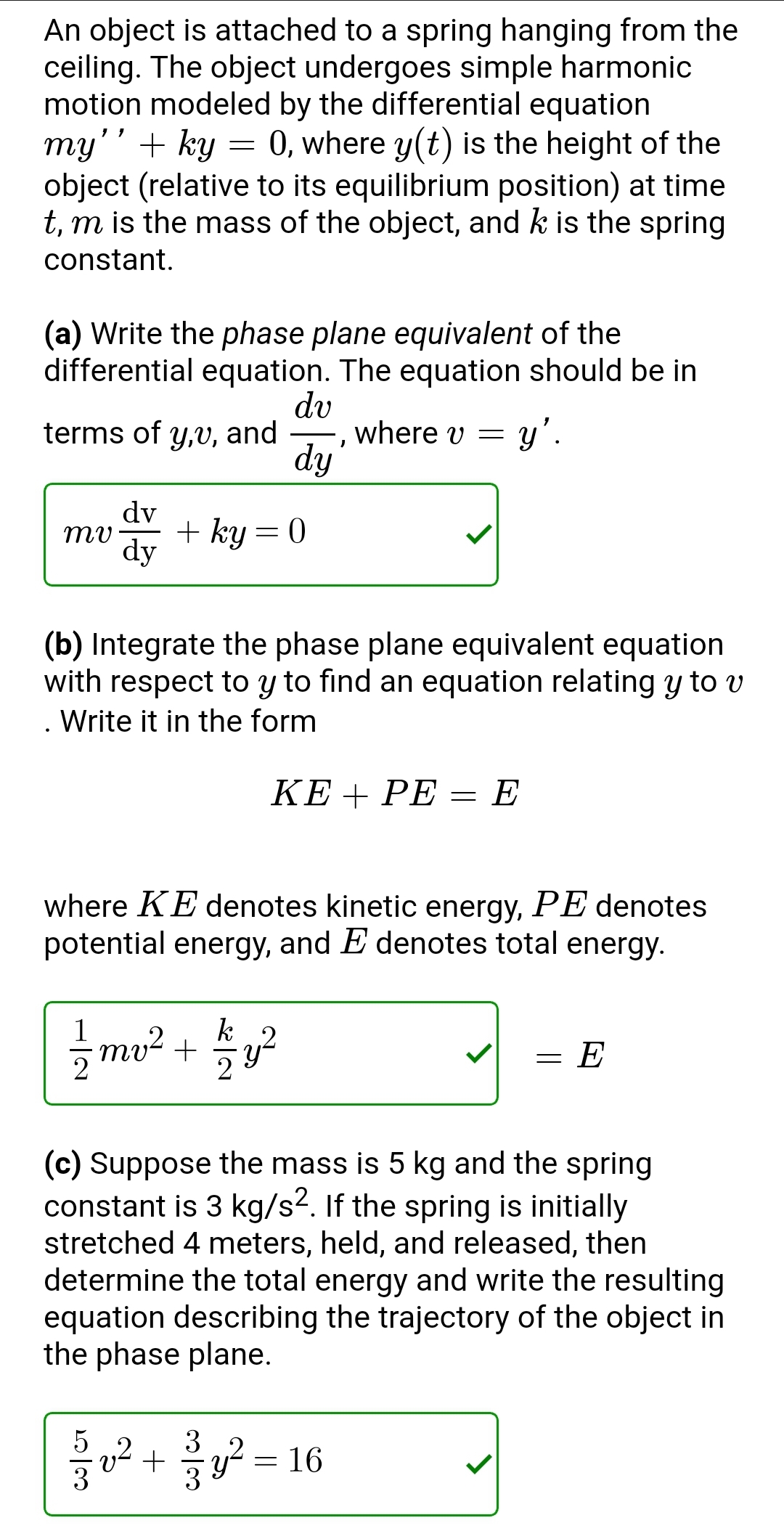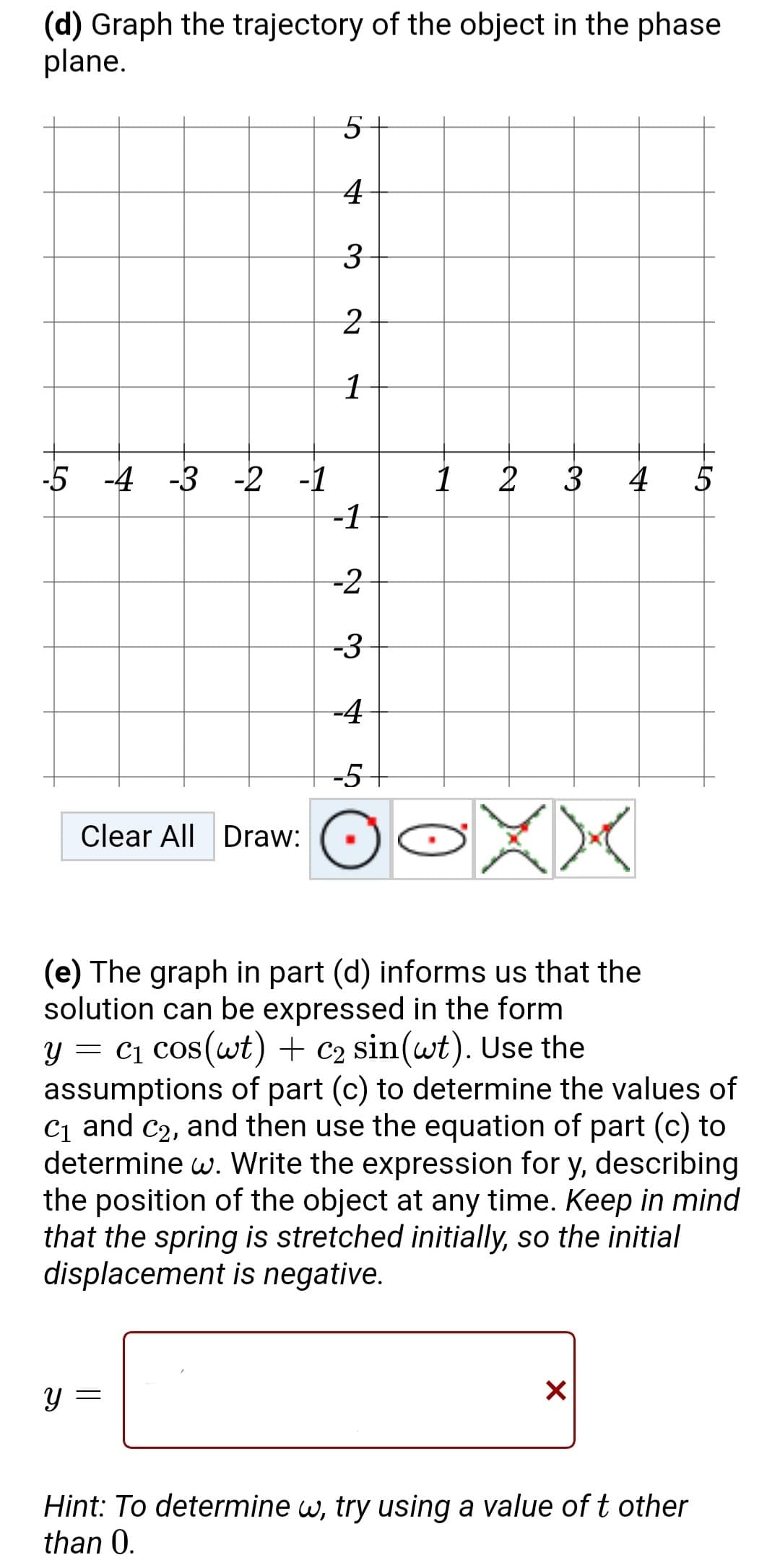An object is attached to a spring hanging from the ceiling. The object undergoes simple harmonic motion modeled by the differential equation my'' + ky = 0, where y(t) is the height of the object (relative to its equilibrium position) at time t, m is the mass of the object, and k is the spring constant. (a) Write the phase plane equivalent of the differential equation. The equation should be in dv terms of y,v, and where v = y'. dy dv mu + ky = 0 dy I (b) Integrate the phase plane equivalent equation with respect to y to find an equation relating y to v Write it in the form KE + PE = E k 1/1/2mv ² + 12/27 y ² where KE denotes kinetic energy, PE denotes potential energy, and E denotes total energy. = E (c) Suppose the mass is 5 kg and the spring constant is 3 kg/s2. If the spring is initially stretched 4 meters, held, and released, then determine the total energy and write the resulting equation describing the trajectory of the object in the phase plane. 37 v² + 3y² = 16
An object is attached to a spring hanging from the ceiling. The object undergoes simple harmonic motion modeled by the differential equation my'' + ky = 0, where y(t) is the height of the object (relative to its equilibrium position) at time t, m is the mass of the object, and k is the spring constant. (a) Write the phase plane equivalent of the differential equation. The equation should be in dv terms of y,v, and where v = y'. dy dv mu + ky = 0 dy I (b) Integrate the phase plane equivalent equation with respect to y to find an equation relating y to v Write it in the form KE + PE = E k 1/1/2mv ² + 12/27 y ² where KE denotes kinetic energy, PE denotes potential energy, and E denotes total energy. = E (c) Suppose the mass is 5 kg and the spring constant is 3 kg/s2. If the spring is initially stretched 4 meters, held, and released, then determine the total energy and write the resulting equation describing the trajectory of the object in the phase plane. 37 v² + 3y² = 16
Advanced Engineering Mathematics
10th Edition
ISBN:9780470458365
Author:Erwin Kreyszig
Publisher:Erwin Kreyszig
Chapter2: Second-order Linear Odes
Section: Chapter Questions
Problem 1RQ
Related questions
Question

Transcribed Image Text:An object is attached to a spring hanging from the
ceiling. The object undergoes simple harmonic
motion modeled by the differential equation
my'' + ky = 0, where y(t) is the height of the
object (relative to its equilibrium position) at time
t, m is the mass of the object, and k is the spring
constant.
(a) Write the phase plane equivalent of the
differential equation. The equation should be in
dv
= y'.
terms of y,v, and where v =
dy
dv
mu + ky = 0
dy
I
(b) Integrate the phase plane equivalent equation
with respect to y to find an equation relating y to v
Write it in the form
KE + PE = E
where KE denotes kinetic energy, PE denotes
potential energy, and E denotes total energy.
k
1/1/2mv ² + 1/2 y ²
=
E
(c) Suppose the mass is 5 kg and the spring
constant is 3 kg/s2. If the spring is initially
stretched 4 meters, held, and released, then
determine the total energy and write the resulting
equation describing the trajectory of the object in
the phase plane.
ร
v²+²²=16

Transcribed Image Text:(d) Graph the trajectory of the object in the phase
plane.
-5 -4 -3 -2 -1
Y
Clear All Draw:
5
4
3
2
1
=
-1
-2
-3
-4
-5
1
2
3
O-XX
(e) The graph in part (d) informs us that the
solution can be expressed in the form
y = C₁ cos(wt) + C₂ sin(wt). Use the
assumptions of part (c) to determine the values of
C₁ and C₂, and then use the equation of part (c) to
determine w. Write the expression for y, describing
the position of the object at any time. Keep in mind
that the spring is stretched initially, so the initial
displacement is negative.
4
X
HEA
Hint: To determine w, try using a value of t other
than 0.
5
Expert Solution
This question has been solved!
Explore an expertly crafted, step-by-step solution for a thorough understanding of key concepts.
This is a popular solution!
Trending now
This is a popular solution!
Step by step
Solved in 3 steps with 3 images

Recommended textbooks for you

Advanced Engineering Mathematics
Advanced Math
ISBN:
9780470458365
Author:
Erwin Kreyszig
Publisher:
Wiley, John & Sons, Incorporated

Numerical Methods for Engineers
Advanced Math
ISBN:
9780073397924
Author:
Steven C. Chapra Dr., Raymond P. Canale
Publisher:
McGraw-Hill Education

Introductory Mathematics for Engineering Applicat…
Advanced Math
ISBN:
9781118141809
Author:
Nathan Klingbeil
Publisher:
WILEY

Advanced Engineering Mathematics
Advanced Math
ISBN:
9780470458365
Author:
Erwin Kreyszig
Publisher:
Wiley, John & Sons, Incorporated

Numerical Methods for Engineers
Advanced Math
ISBN:
9780073397924
Author:
Steven C. Chapra Dr., Raymond P. Canale
Publisher:
McGraw-Hill Education

Introductory Mathematics for Engineering Applicat…
Advanced Math
ISBN:
9781118141809
Author:
Nathan Klingbeil
Publisher:
WILEY

Mathematics For Machine Technology
Advanced Math
ISBN:
9781337798310
Author:
Peterson, John.
Publisher:
Cengage Learning,

